In transit refers to moving goods from a source location to the delivery destination.
Forty-three percent of consumers plan to increase online shopping in the next six months. A well-managed in-transit process balances faster delivery times that meet customer expectations with operational costs that protect margins.
Download Ware2Go’s eBook for more on how to win happier customers with a well-managed fulfillment strategy.
In this guide, we’ll examine how to optimize your shipping strategies and woo customers with optimal in transit processes.
What Is Time In Transit (TNT)?
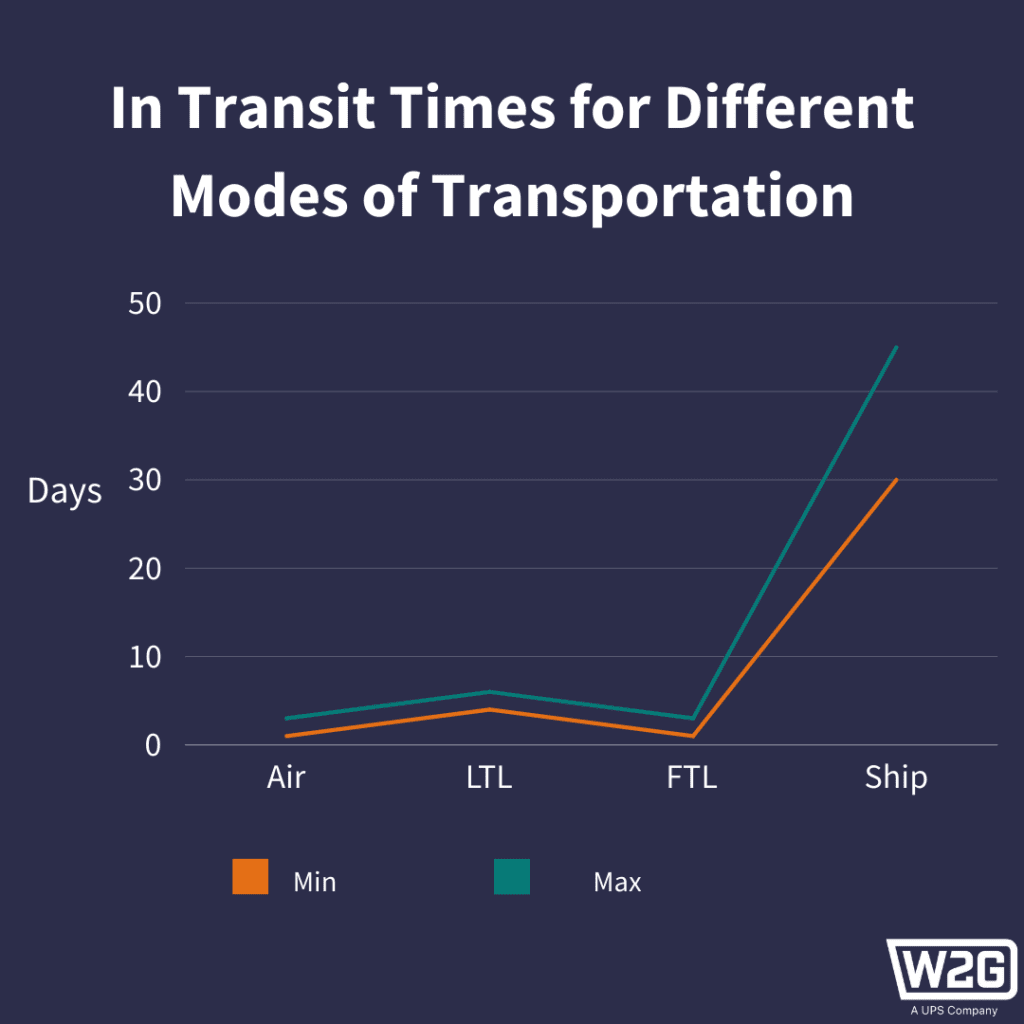
Time in transit (TNT) is the duration it takes for a shipment to be transported and delivered once it has been picked up from the point of departure. Basically, it’s the amount of time spent shipping and delivering products from a merchant’s warehouse to the consumer.
Time in transit varies according to the shipping route or the mode of transportation. For example, transit times for next-day air shipments and ground transportation vary enormously.
Most shipping carriers measure time in transit by hours and days in transit. These measurements are often available for consumers when buying products from merchants that offer last-mile carrier tracking for online purchases.
Time in transit also includes the time it takes to get products from the port to the warehouse. The trucker’s blockades across Canada and the US remind us of how vulnerable supply chains are to geopolitical issues and other constraints. The road occupations led to hundreds of millions of dollars in daily failed deliveries.
There are many factors that may affect what freight transit time is. The time it takes to get your products into the warehouse and sent to the final destination is key.
What Is the Difference between Transit Time and Transport Time?
People often mistake transit time for transport time, leading to unrealistic expectations. Here are the differences:
Transit Time
Definition – Transit time refers to the total time it takes for a shipment to move from the point of origin to the destination.
Inclusions – This includes the time the shipment spends in various stages of the transportation process, such as loading, unloading, and any layovers or stops along the way.
Factors – Transit time can be influenced by the mode of transportation (truck, ship, airplane, etc.), the distance between the origin and destination, the efficiency of logistics operations, and potential delays such as customs clearance or unexpected events.
Transport Time
Definition – Transport time refers to the time a shipment spends moving during transportation.
Inclusions – Transport time doesn’t usually include the time spent in activities like loading, unloading, or other non-movement-related activities.
Factors – It’s more focused on the amount of time the goods are actively moved from one location to another.
Understanding time in transit and associated terms like transport time helps you gauge your shipping efficiency. This provides clues to help optimize your logistics and supply chain to meet customers’ expectations.
What’s Involved in The Transit Process?
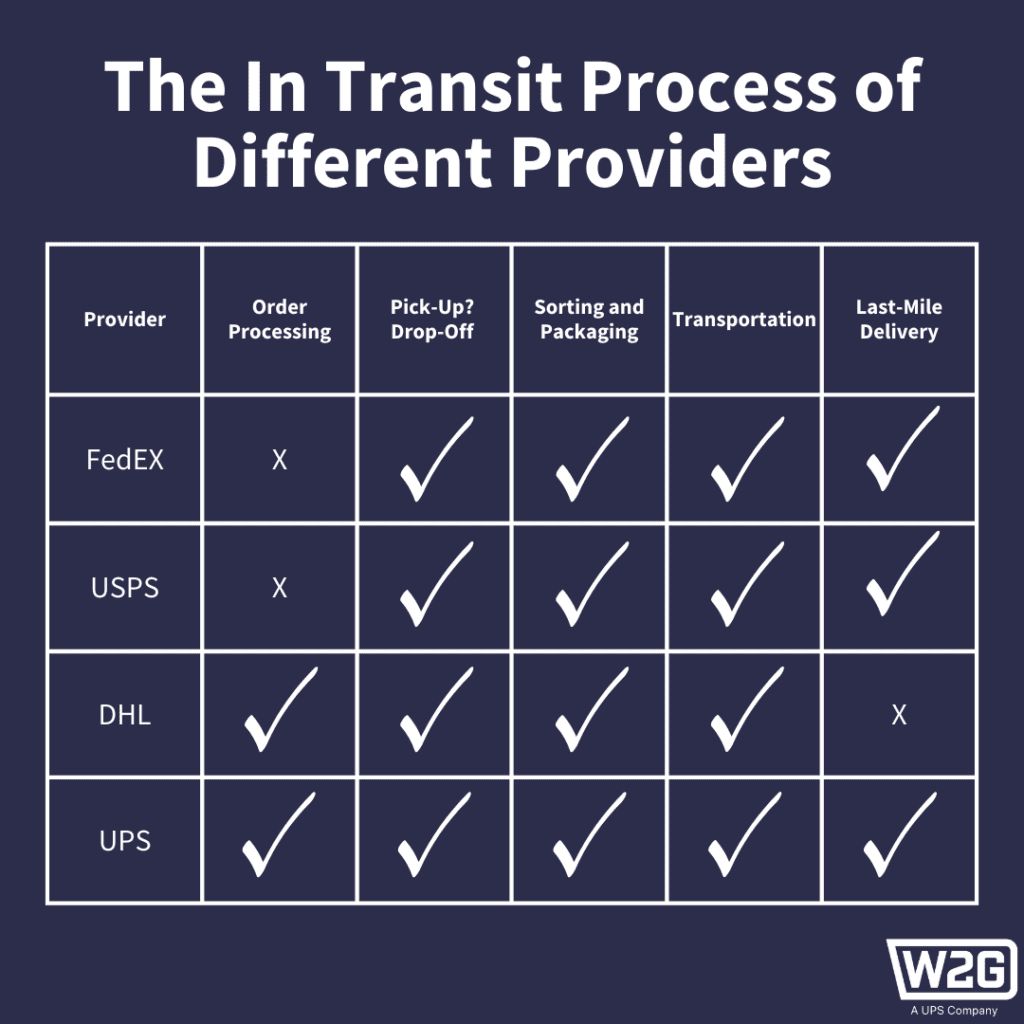
To help you fully understand how it works, here’s a breakdown of the in transit process:
1. Inventory Distribution
It begins with forward-stocking inventory as close as possible to the end customer to reduce the transit distance and delivery time.
2. Order Orchestration
An order orchestration system routes orders from the sales channel to the warehouse.
3. Transportation Mode Selection
The most efficient transportation mode minimizes costs and transit times.
4. Shipment Preparation and Packaging
Proper preparation and packaging ensure product integrity during transit, reducing the risk of damages and returns.
5. Pickup/Drop-off and Transit Departure
Prompt pick-up, drop-off, and transit departure places the shipment en route to timely delivery.
6. Tracking and Monitoring
Shipment visibility provides accurate delivery updates to customers and enables businesses to address any issues proactively.
7. Delivery to Final Destination
Seamless delivery to the final destination breeds customer satisfaction and loyalty.
8. Confirmation of Receipt or Completion
Prompt confirmation of receipt or completion provides closure and reassurance for customers.
These are the components of the in transit process that you need to learn about. Managing these components efficiently can lead to in transit arriving on time, with the product fully intact.
How Does Reducing Time In Transit Affect Your Business?
Some fast-growing brands may be surprised to learn how high their transit times are. They need to identify inefficiencies in their supply chain to lower them for two very important benefits:
- Lowering time in transit for final-mile delivery helps merchants get shipments to end customers faster, which improves customer satisfaction and repeat customers.
- Lowering time in transit also creates a more efficient process for shipping products to end customers, thus lower shipping costs. The longer an item stays on a delivery truck, the higher the price of the final mile delivery.
Environmental Considerations of Time In Transit
Another important factor when considering time in transit is the environmental sustainability of your business model. Consumers value sustainable shipping options. Ware2Go’s 2021 consumer survey revealed that 88% of consumers say sustainability is important to their online shopping decisions, and 41% said that eco-friendly shipping options was one of their top concerns.
Lowering time in transit reduces the costly environmental impact caused by inefficient delivery. The less time merchants take to ship their products to consumers, the lower the carbon footprint of deliveries. Because the transportation sector is the largest contributor to greenhouse gas emissions in the United States, lowering time in transit for final-mile delivery means lower carbon emissions for the country.
However, this mostly applies to ground shipment, as air shipment emits nearly 6 times more carbon than ground shipments. It’s important to reduce reliance on air shipments to the barest by optimizing shipping zones for more efficient ground delivery.
The Importance of Time In Transit and Consumer Expectation

Ware2Go Warehouse US Regions Map and Average Shipping Time
Technological advancements in the fulfillment and logistics industry offer eCommerce merchants valuable opportunities to reach their customers faster and more efficiently. They empower merchants to fulfill increasing demand for products that match up consumers’ environmental values.
However, a consumer survey by Shopify shows that while 49% of consumers said they’re willing to pay extra for a sustainable shipping method, they’re also more likely to opt for a same-day or next-day shipping option when available. Even though consumers want to make an eco-friendly choice, they’re often programmed to make the convenient choice if offered.
Modern-day sustainability-driven shopping habits and the increased demand for 1–2 day home delivery options can can create conflicting priorities for merchants. Overcoming this requires a business model that marries convenience and sustainability.
For example, by using a logistics solution that strategically stocks products closer to customers, merchants lower the time in transit of ground shipments and reduce the environmental impact of next-day air shipments.
To help merchants take their sustainability initiatives even further, Ware2Go’s logistics experts created a fully-funded carbon offset program to help neutralize the carbon output from shipping and delivery. After determining the monthly carbon emissions of all shipments across Ware2Go’s network, our team purchases the equivalent amount of carbon credits for reforestation and forest preservation projects, which draw down a comparable amount of CO2 back from the atmosphere.
Through Ware2Go’s partnership with Pachama, our merchants become part of the mission to restore vital ecosystems, prevent deforestation, and create sustainable forests. They get the best of both worlds: lower time in transit costs with increased customer satisfaction from convenient delivery and greater peace of mind knowing that their shipping is more sustainable.
Factors That Cause Delays and Other Time In Transit Challenges
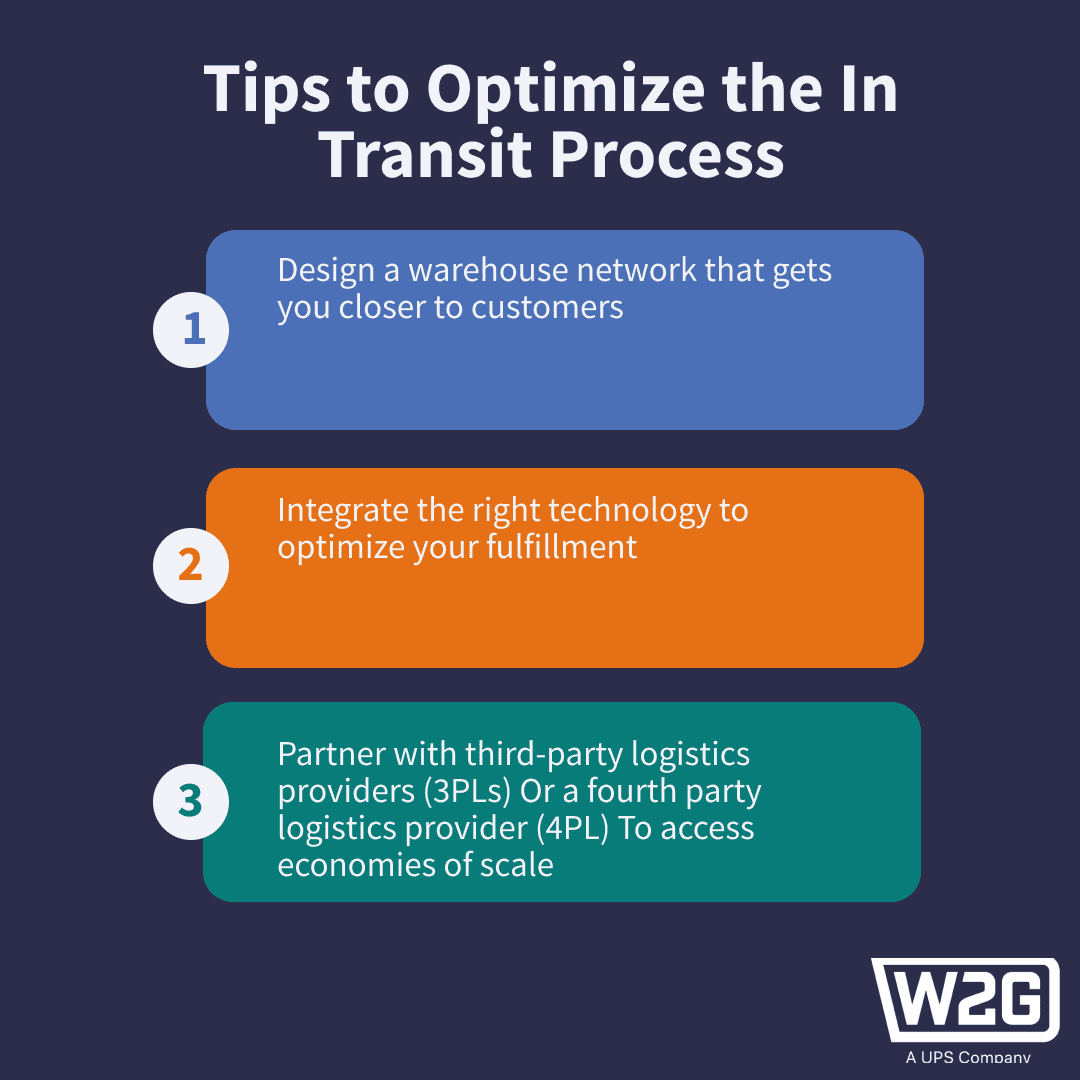
To help merchants get the best of their in transit tracking, this section highlights common factors that lead to in transit arriving late. You can speed up your transit times significantly by managing the following factors effectively:
Weather-Related Disruptions
Merchants that can anticipate and mitigate the impact of weather-related delays are a step closer to ensuring smooth operations and enhanced customer satisfaction. One way to mitigate the effects of inclement weather is by using a warehouse management system (WMS), such as Ware2Go, with advanced order orchestration functionalities to redirect affected orders to the next closest warehouse.
Transportation Infrastructure and Equipment Issues
Infrastructure and equipment issues can cause downtimes in the in transit process. However, proactive maintenance raises the chances of in transit arriving on time always.
Traffic Congestion and Urbanization
Use smart route optimization tools — real-time traffic updates, time window tracker, and multi-stop route planner, etc. — to navigate urban congestion more efficiently for faster in transit times.
Inadequate Communication and Information Sharing
Communication gaps in the supply and distribution chains can also cause delays in transit. However, collaborative platforms and real-time tracking systems can improve communication and information sharing among supply chain partners.
Regulatory and Compliance Hurdles
Shipments often undergo many compliance checks and physical inspections, which can hold up the movement of goods. To streamline your regulatory processes, consider compliance automation tools and strong partnerships with experienced customs brokers.
Geopolitical Factors
Protect your shipping operations from disruptions due to regional policies and political instability. Stay informed by subscribing to newsletters from trusted sources and joining trade-focused professional groups. These actions will keep you prepared and able to adapt quickly to changes.
Enhance your understanding through international trade and risk management courses, and consult with experts to tailor your strategies. Use advanced tools to monitor geopolitical risks, which will improve your decision-making.
These proactive steps are key to optimizing delivery times and increasing customer satisfaction.
Learn How to Calculate Time In Transit through Shipping Zones
To calculate the time in transit of a shipment, it’s important to know what shipping zones are and their key role in delivery times.
A shipping zone is a geographic region which carriers deliver goods, categorized by zip code groups.
What Are Shipping Zones?
Shipping zones are often measured and assigned by the distance between a shipment’s point of origin and its final destination. In the United States, domestic shipping zones span between Zone 1 (0–15-mile distance) and Zone 8 (1,801 miles or more).
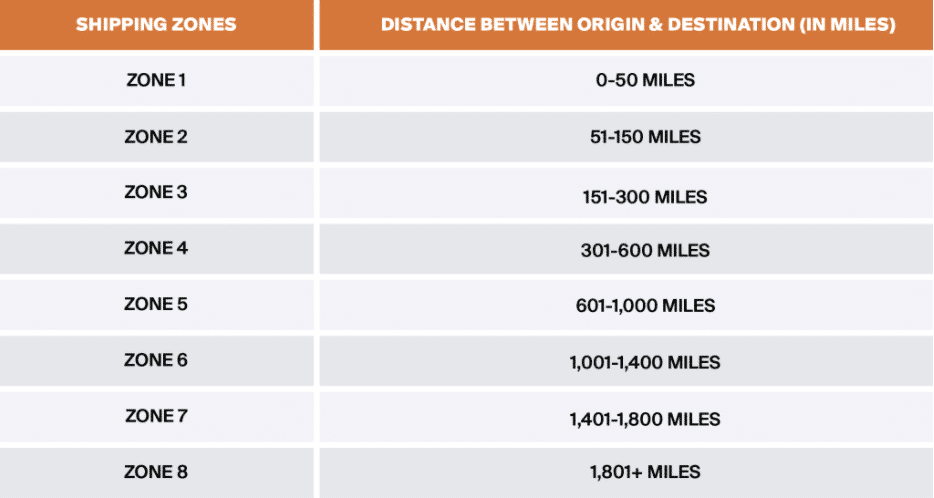
How to Calculate Shipping Zones & Time In Transit
Most shipping carriers, such as UPS, determine shipping zones by measuring the distance a shipment travels. If 2 packages are shipped to the same location but sent from 2 different warehouses, they could have different shipping zones.
UPS calculates shipping zones based on a package’s distance, using the first 3 digits of the shipping item’s origin and destination zip codes. The first 3 digits of each zip code indicate a shipment’s approximate location, allowing postal services to more accurately determine the item’s origin, delivery location, and transit time.
For instance, a shipment traveling from Atlanta, GA, to Columbus, GA (within the same state) would have zip code prefixes of 303- and 319- and, therefore, would be calculated as Zone 1.
The further the distance, the more expensive the shipping and the higher the zone number. Therefore, businesses must design a logistics model that lowers the distance and time needed to deliver a package.
This lowers the cost of shipping, which helps drive business growth and increase customer retention. Higher shipping costs discourage customers from placing orders; hence, lower shipping costs reduce cart abandonment rates.
Other Important Delivery Tracking Terms Besides In Transit
Time in transit is one of many important terminologies in the shipping process. Understanding these shipping terms is crucial to shaping expectations about the in transit process. These include the following.
Real-Time Tracking
Real-time tracking allows businesses to monitor shipment progress continuously from the factory floor to the doorstep.
Estimated Time of Arrival (ETA)
ETA estimates how long the in transit will take, providing a set date to expect doorstep delivery. Communicating accurate ETAs to customers instills confidence and helps promote business stability and continuity.
Carrier Tracking Number
Carrier tracking number enables customers to track their shipments independently, giving them constant access to updates on the shipment status.
Last-Mile Delivery
Last-mile delivery refers to the final shipment movement from a warehouse or distribution center to the customer’s location. You can optimize last-mile delivery through forward-stocking at close destinations, route optimization, and alternative delivery options like 4PL services.
Delivery Confirmation
Promptly confirming deliveries through automated notifications or confirmation emails reassures customers and reduces post-delivery inquiries.
Proof of Delivery (POD)
Electronic proof of delivery methods, such as digital signatures or barcode scanning, provide businesses with undeniable proof of successful delivery.
Electronic Data Interchange (EDI) and Signature Capture
EDI systems streamline documentation processes to enhance data accuracy.
These are the essential delivery tracking terms beyond ‘in transit.’ They’re the terminologies facilitating clear communication for collective monitoring of shipment progress by businesses, supply chain partners, and end customers.
How to Reduce Shipping Transit Times
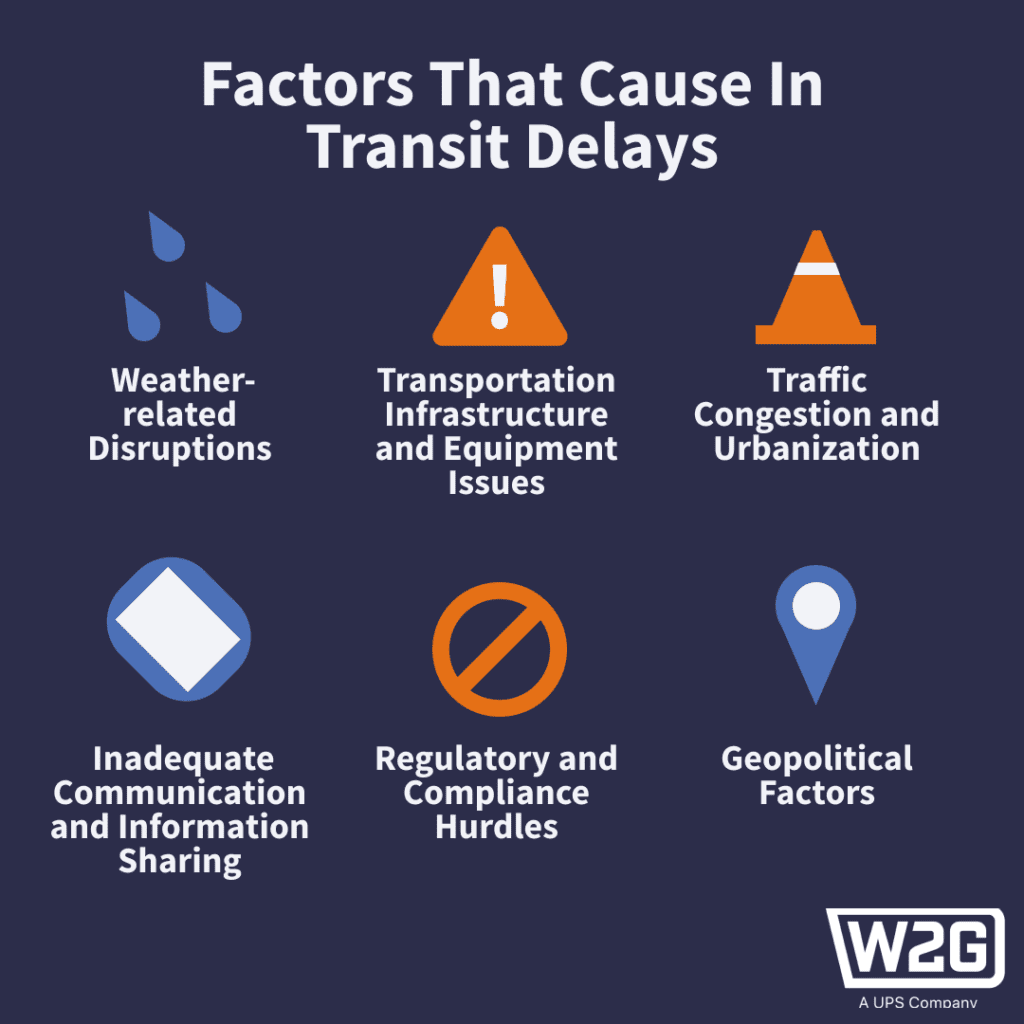
This section elaborates on tips for fast-tracking the in transit process. Below is expert-vetted advice to help you minimize uncertainties in your shipping process.
- Design a Warehouse Network That Gets You Closer to Customers. The proximity of your inventory to your end customer is one of the most important factors affecting the cost and speed of shipping. Since affordable and fast delivery is important to consumers, optimizing your warehouse networks based on your product’s end destination will help you reach your customers cost-efficiently. Fast growing brands can identify optimal warehouse placements to ship domestically, allowing them to distribute inventory to multiple locations and optimize their proximity to customers to quickly and affordably ship to them.
- Integrate the Right Technology to Optimize Your Fulfillment. Optimizing your fulfillment operations also requires software to seamlessly integrate with different online marketplaces and ecommerce platforms. By applying the right eCommerce technology, merchants can manage and automate order fulfillment across multiple channels and warehouses within their network.
Ware2Go’s Warehouse management platform, NetworkVu, allows merchants to optimize the speed of their fulfillment operation by giving them visibility of inbound deliveries, inventory levels, and outbound shipping performance. NetworkVu also uses machine learning algorithms to get smarter as merchants use our technology. By learning more about merchant’s unique shipping patterns over time, NetworkVu offers progressively better recommendations to ensure that all fulfillment processes in the warehouse are moving as efficiently and cost-effectively as possible.
- Partner with Third Party Logistics Providers (3PLs) or a Fourth Party Logistics Provider (4PL) to Access Economies of Scale. While small- to medium-sized businesses may understand the importance of reducing transit times, it’s often too costly to justify implementing insourced warehouses.
The solution is to partner with a tech-enabled logistics network like Ware2Go to optimize your supply chain planning and find prime warehouse locations for fast customer delivery. Investing in a 4PL provider and outsourcing fulfillment service allows merchants to easily reduce shipping costs, access the latest technology and transportation, and take advantage of economies of scale. This can facilitate fast-growing brands to offer 1–2 day delivery, with decreased transit time for shipments and reduced shipping and environmental costs.

FAQs
Do you have questions about packages in transit? We’ve got you covered with answers to some of the most frequently asked questions:
What Should I Do If My Package Is Stuck In Transit for an Extended Period?
Start by checking the tracking information provided by the carrier. Sometimes delays occur due to unforeseen circumstances like weather events or transportation issues. Contact the shipping carrier or the merchant you purchased from to inquire about the status and potential reasons for the in transit arriving late.
Why Does My Package Have Multiple ‘In Transit’ Updates?
Seeing multiple ‘in transit’ updates is normal, especially for packages traveling long distances or going through multiple transit points. Multiple ‘in transit’ updates may occur when your package moves through various sorting facilities or transportation hubs. Each update signifies progress in the transit process. However, if you notice excessive or prolonged ‘in transit’ statuses without movement, contact the carrier for clarification.
Will My Package Be Delivered on Weekends or Holidays While In Transit?
Most carriers operate on weekends and holidays, so there’s a good chance your package will continue its journey during these times. However, delivery schedules may vary depending on the carrier and your shipment’s circumstances, from the distance to the chosen carriers and mode of transport. Check the carrier’s website or tracking information for estimated delivery dates to confirm if your package will arrive on weekends or holidays.
What Happens If My Package Gets Lost or Damaged During Transit?
If your package is lost or damaged during transit, you should contact the carrier or the sender immediately to report the issue. Provide any relevant documentation, such as tracking numbers and photographs of the damage, to expedite the resolution process. They’ll initiate an investigation, and you may receive compensation or a replacement shipment.
Can I Change the Delivery Address or Request a Delivery Hold While My Package Is In Transit?
Depending on the carrier’s policies and the stage of transit, you may have the option to change the delivery address or request a delivery hold. However, these changes may incur additional fees or delays. Contact the carrier or the merchant as soon as possible to inquire about available options and any associated fees or restrictions. Ware2Go’s clients can re-route a delivery once it’s in transit through package intercept feature in the self-service portal.
Next Steps for Optimizing Your Product’s Time In Transit
Reducing time in transit has become a vital strategy for eCommerce fulfillment. 4PL services like Ware2Go help small to medium businesses of different sizes and industries calculate and minimize their time in transit costs so that merchants can afford to offer customers positive delivery experiences, such as guaranteed 1–2 day shipping.
Contact Ware2Go’s supply chain experts for a free consultation to get the best advice for optimizing transit costs. By partnering with a 4PL service like Ware2Go, you could save a significant amount on shipping expenses while still offering free nationwide 1–2 day shipping.




